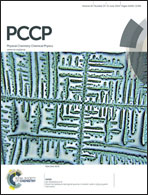Interplay between the ionic and electronic transport and its effects on the reaction pattern during the electrochemical conversion in an FeF2 nanoparticle
Abstract
Using a charge dependent embedded atom method potential in conjunction with a dynamically adaptive multibody force field, the conversion reaction in an iron difluoride nanoparticle exposed to lithium ions is investigated. The reactions take advantage of the multiple valence states of the cations. A subtle interplay between the ionic and electronic transport, which is not accessible in conventional fixed-charge simulations, has been revealed. The simulated reaction pattern is in close agreement with that observed experimentally at the nanoscale, while providing detailed atomistic mechanisms. Due to difference in the ionic and electronic transport, different stages of reaction are observed and the corresponding phase growth mechanisms have been identified. Initially local Li concentration plays a key role in driving the reaction through amorphous reaction products to the crystalline phases that inhibit Li transport. However, electronic transport and interfacial ion diffusion are shown to be important in creating further transport pathways that allow continued conversion reactions, providing the mechanism that enables the use of these materials in advanced high capacity lithium ion batteries. Such interplay between the ionic and electronic transport will also be important in other materials and devices for energy conversion and storage.


 Please wait while we load your content...
Please wait while we load your content...